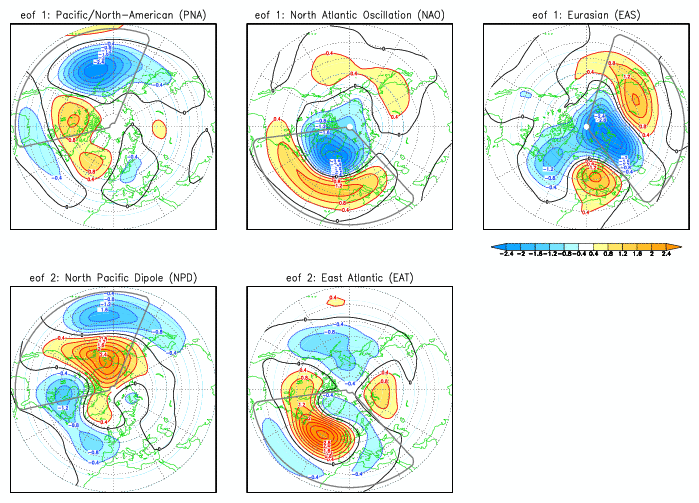Northern Hemisphere winter teleconnections
Explanation of the derivation of the teleconnection climagrams available on Opencharts.
A variety of statistical methods have been used in the literature to define Northern-Hemisphere (NH) teleconnection patterns. Here, leading variability patterns for the NH winter are defined by an EOF analysis of re-analysis monthly-mean geopotential height at 500 hPa for the December-to-March season, in the 30-year period (1981-2010).
The analysis has been applied to three sectors within the latitude belt 25N-85N:
- the Pacific/North American sector (160E-80W).
- the Atlantic/European sector (80W-40E).
- the Asian/Pacific sector (40E-160E).
The portion within the grey sector boundary corresponds to the regionally-normalized EOF. For continuity, regressions of height anomalies onto the corresponding PC are shown over the whole hemisphere.
Data are from the ERA-Interim re-analysis until winter 2009/10, from operational ECMWF analyses thereafter.
Fig8.3.4.4-1: Northern Hemisphere winter teleconnections
EOF No1 is defined in each of the three sectors and corresponds to a well-documented teleconnection pattern:
- the Pacific/North American pattern.
- the North Atlantic Oscillation.
- the Eurasian pattern.
The positive phase of these patterns corresponds to an intensification of the westerly winds over:
- central and eastern parts of the North Pacific.
- central and eastern parts of the North Atlantic.
- over central and eastern Siberia.
These patterns are shown in the top row of Fig8.3.4.4-1.
EOF No2 of the Pacific/North American and the Atlantic/European sector are also retained. This is because they modulate the intensity and position of the stationary-wave ridges over:
- the north-eastern parts of the Pacific Ocean.
- the north-eastern parts of the Atlantic Ocean.
The positive EOFs correspond to an amplification of stationary-wave ridge pattern. These are referred to as:
- the North Pacific dipole.
- the East Atlantic pattern.
These patterns are shown in the bottom row of Fig8.3.4.4-1.
